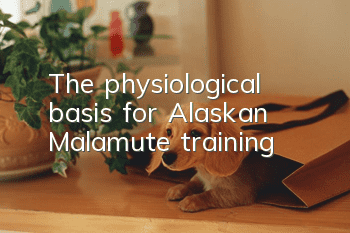The physiological basis for Alaskan Malamute training

Although the IQ ranking of Alaskan Malamutes is relatively low, there is no stupid dog. As long as the owner is patient, they can be trained.
1. Types of reflex activities
1. Unconditioned reflex
It is a congenital reflex that is present at birth. For example, puppies are born with the ability to suck, breathe, defecate, urinate, defend themselves, etc. This reflex is relatively stable and is also the basis for establishing the dog’s conditioned reflex.
2. Conditioned reflex
It is acquired and gradually formed in the life of the dog. It is difficult for dogs to maintain normal physiological activities in an ever-changing environment. They must rely on the functional activities of the high-level nerve center (cerebral cortex) on the basis of unconditioned reflexes to establish an adaptive system that is larger than the number of unconditioned reflexes. Stronger conditioned reflexes. It can also be said that conditioned reflexes are established by dogs under certain living conditions. They are unstable and temporary, and are easy to occur and disappear. Every action that people teach dogs is a conditioned reflex. It must be repeatedly trained regularly and continuously strengthened before it can be consolidated. Otherwise, after a long period of time, the conditioned reflex will fade and disappear, and the learned actions will be lost. Will forget.
2. Training dogs to establish and strengthen conditioned reflexes
The process of training a dog to learn various skills is the process of forming a conditioned reflex in the dog. It can be seen from the above principles that whether it is to cause unconditioned reflex or conditioned reflex, stimulation (unconditioned stimulus and conditioned stimulus) is required. When the two stimuli are combined, the conditioned reflex can be strengthened. For example, training a dog to make the "come here" action from issuing the command to "come here" is a reflex and a conditioned reflex stimulus. When the sound stimulation of "come here" is combined with the stimulation of the action of "come here", two excitement points will be generated in different areas of the dog's cerebral cortex.
When the conditioned reflex is not formed, there is no connection between these two excitement points, no matter how loud you shout. No matter how hard you wave, the dog won't come over. If two stimuli are combined at the same time, that is, after using them several times at the same time, the two excitement points will be connected. In the future, as long as the command "come here" is given, the dog will come over obediently without waving. This is conditioned reflex. Formation should be rewarded. People use the physiological characteristics of dogs to form conditioned reflexes and conduct a series of trainings on dogs according to people's purposes.
When training dogs to establish and strengthen conditioned reflexes, you should pay attention to the following points:
First, conditioned stimuli must be used in conjunction with unconditioned stimuli. Conditioned reflex is the result of the combination of conditioned stimulus and unconditioned stimulus. There is no unconditioned stimulus.Reflection and conditioned reflex cannot be formed. For example, "picking up" is a dog's instinct. It is an unconditioned reflex of dogs and is the basis for establishing conditioned reflexes. During training, as long as appropriate holding objects and commands (conditioned stimulation) are used, the "picking" movements required by the training subjects can be trained.
Second, look at the action time of the two stimuli. The effects of conditioned stimuli should be slightly earlier than the effects of unconditioned stimuli. In this way, the conditioned reflex will be established quickly and consolidated, otherwise. Conditioned reflexes are difficult to form, and even if they are formed, they are very slow and unconsolidated. This requires that when we train a dog, the conditioned stimulation such as commands and gestures must precede the unconditioned stimulation of pulling on the leash and pressing a certain part of the dog's body. Only in this way can the dog quickly learn the taught actions. If two stimuli are given at the same time, the establishment of conditioned reflexes is slower. If the unconditioned stimulus precedes the conditioned stimulus, the dog will have difficulty learning the taught action.
Third, the intensity of stimulation must be correctly grasped. Stimulation that is too strong or too weak will not have a good effect. certainly. The nerve type of the dog and its sensitivity to stimulation should be taken into consideration. Often the same intensity of stimulation will have different effects on different dogs. Generally speaking, conditioned reflexes can only be established when the physiological intensity of the conditioned stimulus is weaker than the intensity of the unconditioned stimulus.
Fourth, to establish a good conditioned reflex, the dog’s cerebral cortex must be awake and uninterrupted by other stimuli. If the dog is in a sleepy or depressed state, the formation of conditioned reflex will be very slow. Not even possible.
Fifth, the unconditioned reflex center related to establishing conditioned reflex must be in a state of considerable excitement. Unconditioned reflexes are the basis for establishing conditioned reflexes. If the unconditioned reflex center lacks sufficient excitement, it will be very difficult to establish a conditioned reflex. For example, if a dog participates in training after eating, the excitability of the dog's food center will be very low at this time. If food is used as an unconditioned reflex stimulus to strengthen the conditioned stimulus, its effect will be insignificant.
- Teach you how to raise a dog correctly? Just read this article!
- What causes dogs to foam at the mouth?
- What should I do if my dog has enteritis? Symptoms and treatments for dog enteritis
- What to do about constipation in Komondor dogs
- Do you know these precautions for raising Shiba Inu?
- Diagnosis and treatment of canine hookworm disease
- How to raise a pug? How to raise pug dogs
- The Importance of Calcium and Phosphorus in Raising a German Shepherd Dog
- What's going on if the dog doesn't eat and has no energy?
- What to do if your puppy has a runny nose



